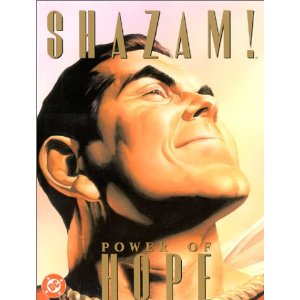When it comes to painted comics, Alex Ross is the first name that comes to everyones mind. He didn’t invent them, but everyone seems to think that he did. I usually like his work, but I seem to be one of the few that thinks that he is over exposed these days. Perhaps I chaffed when he ranked higher than Frank Frazetta on the CBG poll of the Centurys favorite comic painters. He’s been very busy for the last few years. It seems that if there are multiple covers to a book, one of them will most likely be by Ross. So I hope that I can be forgiven if I have been a little grumpy with some of his work. I will be the first to admit that when he is on top of his game, his art is exceptional.
For the last two years, DC has released an oversized book teaming Ross with Paul Dini. The first, two years ago, was Superman: Peace On Earth, followed the next year by Batman: War Of Crime. This year we get the third- Shazam: Power Of Hope. The first two were similar in approach. Unlike the tabliods of the 70’s, neither had featured an Earth shattering battle. No Superman Vs. Muhammed Ali or Batman Vs. The Hulk. Both the Superman and the Batman tales were gentle stories exploring the moral outlook of each character. So what can we expect when the third tabloid features a character who is often considered to be hopelessly out of step with the more cynicle present? After all, many talents have attempted to update Captain Marvel for modern readers with usually disasterous results. Jerry Ordway did a terrific job on the Power Of Shazam series, but low sales showed that readers were ultimately not interested. Perhaps the Captains most successful modern appearance was in the Kingdom Come mini series. The climactic battle between him and Superman was a highlight of the book, and managed to satisfy fans of both characters (who had for years argued over who would win a fight between the two). Of course, that battle was drawn by Alex Ross, so many of his fans have been anxious to see him illustrate a whole book of the Big Red Cheese.
For all the Wolverine fans who have no knowledge of Captain Marvel, his origin is given a breif look in the first two pages of the book. Utilizing a monochomatic color scheme, young Billy Batson meets the old wizard Shazam who gives him the power of six mythological figures. All Billy has to do is say the name of the wizard and he is transformed by a bolt of magical lightning into the mighty Captain Marvel. The book then gets rolling with a stiking three page sequence where Captain Marvel caps a volcano. As he battles various menaces over the next few pages, you notice immediately that Captain Marvel smiles as he does his good deeds. Already we see what sets him apart from the crowd of grim somewhat-heroes of today. As much as Captain Marvel seems to enjoy himself, when the story cuts to Billy Batson, we see that he is exausated and unhappy. Warned by the old wizard that a special child will face despair and look to Captian Marvel for hope, he begins to answer mail from sick children. As he begins to awkwardly help them, he realizes that despair strikes even the most powerful. Sometimes it takes more that great strength to face the worlds problems.
Paul Dini has fassioned the kind of tale that wins you over, even as you predict the outcome. While the ending may come as no real surprise, it is still satisfying. It is the most basic of moral tales, which is fitting for such a naive character as Captian Marvel. The prose is never excessive, as Dini wants to let the art tell most of the story. Ross is obviously comfortable with Dini’s work, as he turns in some of his best storytelling here. This is possibly the best of the three books, not because of any spectacular scenes, but because of the way that Ross lets facial expressions tell the story rather that depend on dialog. There are some spectacular moments, such as a beautiful two page spread where Captain Marvel streaks away from the Rock of Eternity. Mostly, however, you could read this book by just following the Captains face from page to page. If fact, I challange you to do just that. Read the book using nothing more that Cap’s face. That it works shows just what Alex Ross is capible of. Toward the end of the book, as he stands before the wizard Shazam in a poignant moment, we see the face of an adult, and yet the young boy comes through clearly. It is the crux of the story, and would have never worked had Ross not been able to pull it off so flawlessly.
Ultimatly, Shazam: The Power Of Hope is a book that is intended to melt the heart of all the jaded cynics that so many of us have become. I can’t guarantee that it will succeed. Perhaps we are too far gone for an anachronism like the Big Red Cheese to make much of an impact. I’m sure that many will find the moral of the story trite and naive. If it can’t melt our armor, at least it will present us with a view made by a young boy who has the power not just of a man, but a superhero. If he can keep his ideals, we should be humbled that we can’t.
Originally Reviewed November 22nd, 2000


